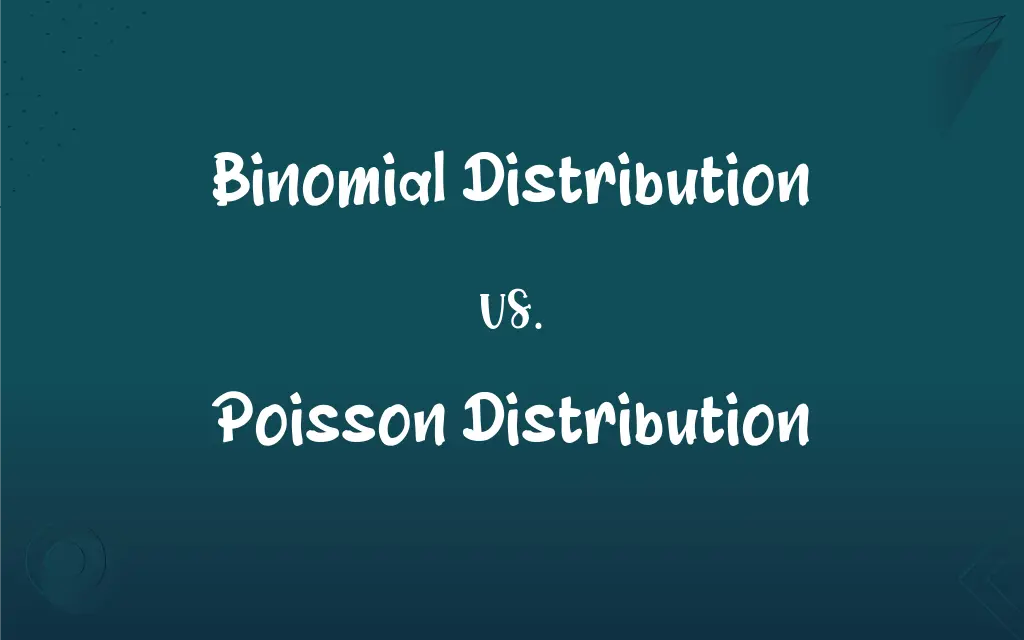Binomial Distribution vs. Poisson Distribution: What's the Difference?
Edited by Aimie Carlson || By Janet White || Published on February 21, 2024
The binomial distribution models the number of successes in a fixed number of independent binary trials, while the Poisson distribution models the number of events in a fixed interval of time or space.

Key Differences
Binomial distribution applies when an experiment consists of a fixed number of independent trials, each with two possible outcomes (success or failure). In contrast, Poisson distribution is used when we are counting the number of times an event occurs in a given interval of time or space.
The probability of success in each trial is constant in a binomial distribution, making it suitable for experiments like coin tosses or quality control tests. Poisson distribution, however, deals with rare or infrequent events, such as the number of cars passing a checkpoint in an hour.
In binomial distribution, the number of trials (n) is a key parameter, along with the probability of success (p). For Poisson distribution, the key parameter is the average number of events (λ, lambda) in the specified interval.
Binomial distribution is discrete, and its outcomes are symmetric when p = 0.5 but become skewed as p deviates from 0.5. Poisson distribution is also discrete, generally skewed, and becomes more symmetric as λ increases.
When the number of trials in a binomial distribution is large and the probability of success is small, the binomial distribution can be approximated by a Poisson distribution, with λ approximated as n*p.
ADVERTISEMENT
Comparison Chart
Application
Fixed number of trials
Number of events in an interval
Type of Events
Binary outcomes (success/failure)
Count of occurrences
Key Parameters
Number of trials (n) and success probability (p)
Average rate of occurrence (λ)
Event Frequency
Not specific to rare events
Typically models rare or infrequent events
Distribution Shape
Symmetric at p=0.5, skewed otherwise
Generally skewed, more symmetric with higher λ
ADVERTISEMENT
Binomial Distribution and Poisson Distribution Definitions
Binomial Distribution
Binomial distribution is used when each trial is independent and has only two outcomes.
In quality control, binomial distribution assesses the probability of a certain number of defective items in a batch.
Poisson Distribution
Poisson distribution models the probability of a number of events occurring in a fixed interval.
Poisson distribution estimates the number of calls a call center receives per hour.
Binomial Distribution
Binomial distribution is discrete and can be symmetric or skewed based on success probability.
In a multiple-choice test with true/false questions, binomial distribution predicts the number of correct answers.
Poisson Distribution
Poisson distribution is used for rare or infrequent events.
Estimating the number of meteor sightings in a year is a use case for Poisson distribution.
Binomial Distribution
Binomial distribution models the probability of a fixed number of successes in binary trials.
Flipping a coin 10 times, binomial distribution calculates the probability of getting exactly 6 heads.
Poisson Distribution
The key parameter in Poisson distribution is the average number of occurrences (λ).
In traffic analysis, Poisson distribution calculates the probability of a certain number of accidents at an intersection.
Binomial Distribution
The parameters of binomial distribution are the number of trials and the probability of success in each trial.
In a survey, binomial distribution helps to find the probability of a specific number of positive responses.
Poisson Distribution
Poisson distribution is discrete and often skewed, especially for small values of λ.
Predicting the number of times a rare bird is spotted in a reserve involves Poisson distribution.
Binomial Distribution
In binomial distribution, each trial is independent, and the total number of trials is fixed.
The probability of getting a specific number of heads in 20 coin tosses is calculated using binomial distribution.
Poisson Distribution
Poisson distribution is ideal for events that occur independently.
The number of emails a company receives daily can be modeled using Poisson distribution.
FAQs
What are the key parameters of binomial distribution?
The number of trials (n) and the probability of success (p) in each trial.
What is a Poisson distribution?
A distribution that models the number of events in a given time or space interval.
What is a binomial distribution?
A distribution that models the number of successes in a fixed number of binary trials.
When do you use a binomial distribution?
When an experiment involves a fixed number of independent trials with two possible outcomes.
Is Poisson distribution always skewed?
It's usually skewed, especially for small λ values, but becomes more symmetric as λ increases.
Does binomial distribution require a fixed number of trials?
Yes, the number of trials must be predetermined.
What is λ in Poisson distribution?
Lambda (λ) is the average rate of occurrence over the interval.
What type of events does Poisson distribution model?
It models rare or infrequent events in a specified interval.
Can binomial distribution be symmetric?
Yes, when the probability of success is 0.5, it's symmetric.
What is the difference in application between these distributions?
Binomial is for fixed number trials, Poisson for counting events in intervals.
How are the outcomes of binomial distribution represented?
As discrete values, representing the number of successes.
Can binomial distribution be approximated by Poisson distribution?
Yes, when the number of trials is large and the probability of success is small.
Is success probability constant in binomial distribution?
Yes, it remains the same across all trials.
What does a large λ indicate in Poisson distribution?
A higher frequency or rate of the events occurring.
In which fields is binomial distribution commonly used?
In fields like quality control, survey analysis, and medical research.
Where is Poisson distribution frequently applied?
In fields such as traffic flow analysis, call center operations, and environmental studies.
Are outcomes in binomial distribution interdependent?
No, each trial is independent of the others.
Can Poisson distribution have a large number of occurrences?
Yes, especially if the average rate λ is high.
Can Poisson distribution predict exact timing of events?
No, it predicts the count of events, not their specific timing.
What is the nature of events in Poisson distribution?
The events are independent and randomly occur in the interval.
About Author
Written by
Janet WhiteJanet White has been an esteemed writer and blogger for Difference Wiki. Holding a Master's degree in Science and Medical Journalism from the prestigious Boston University, she has consistently demonstrated her expertise and passion for her field. When she's not immersed in her work, Janet relishes her time exercising, delving into a good book, and cherishing moments with friends and family.
Edited by
Aimie CarlsonAimie Carlson, holding a master's degree in English literature, is a fervent English language enthusiast. She lends her writing talents to Difference Wiki, a prominent website that specializes in comparisons, offering readers insightful analyses that both captivate and inform.
































































